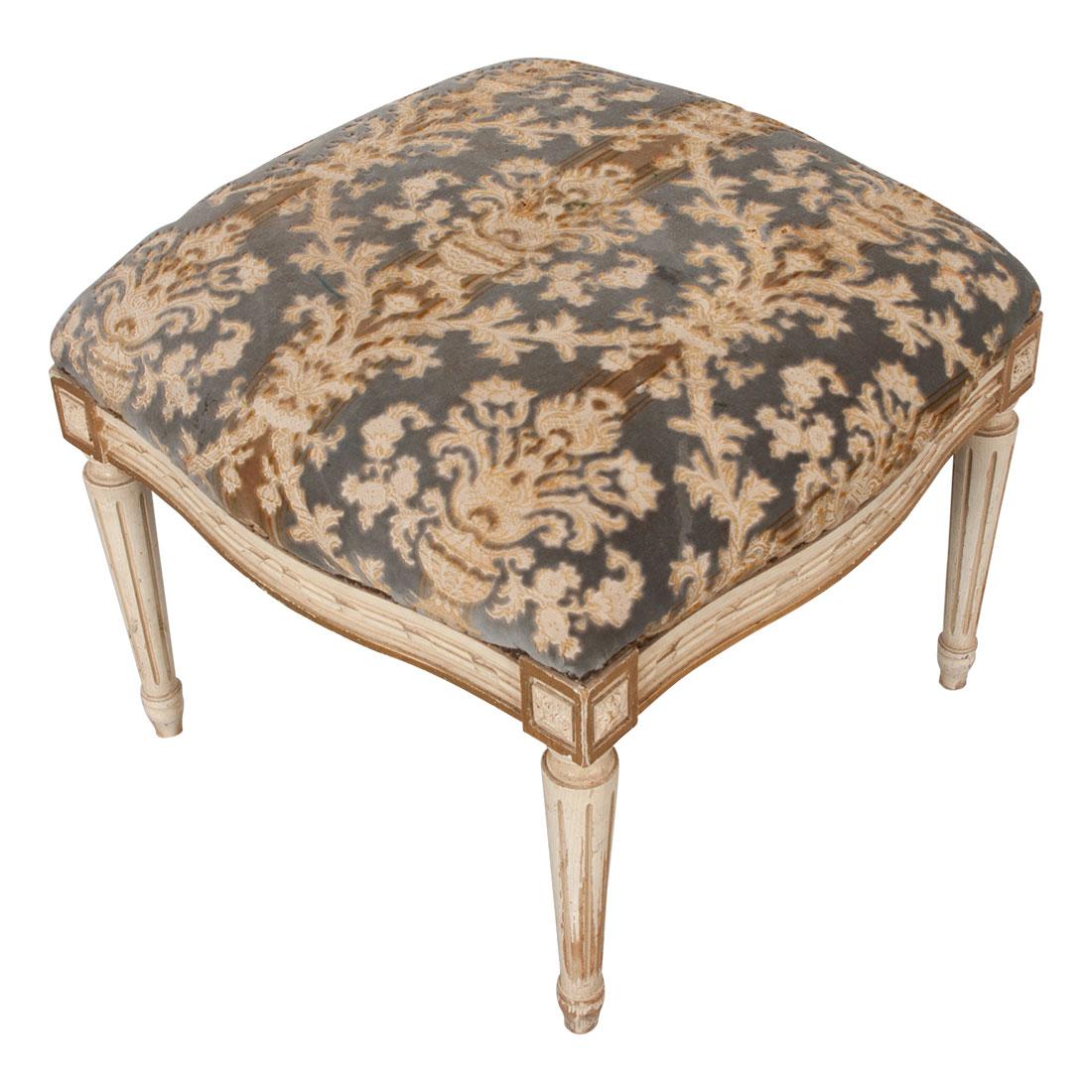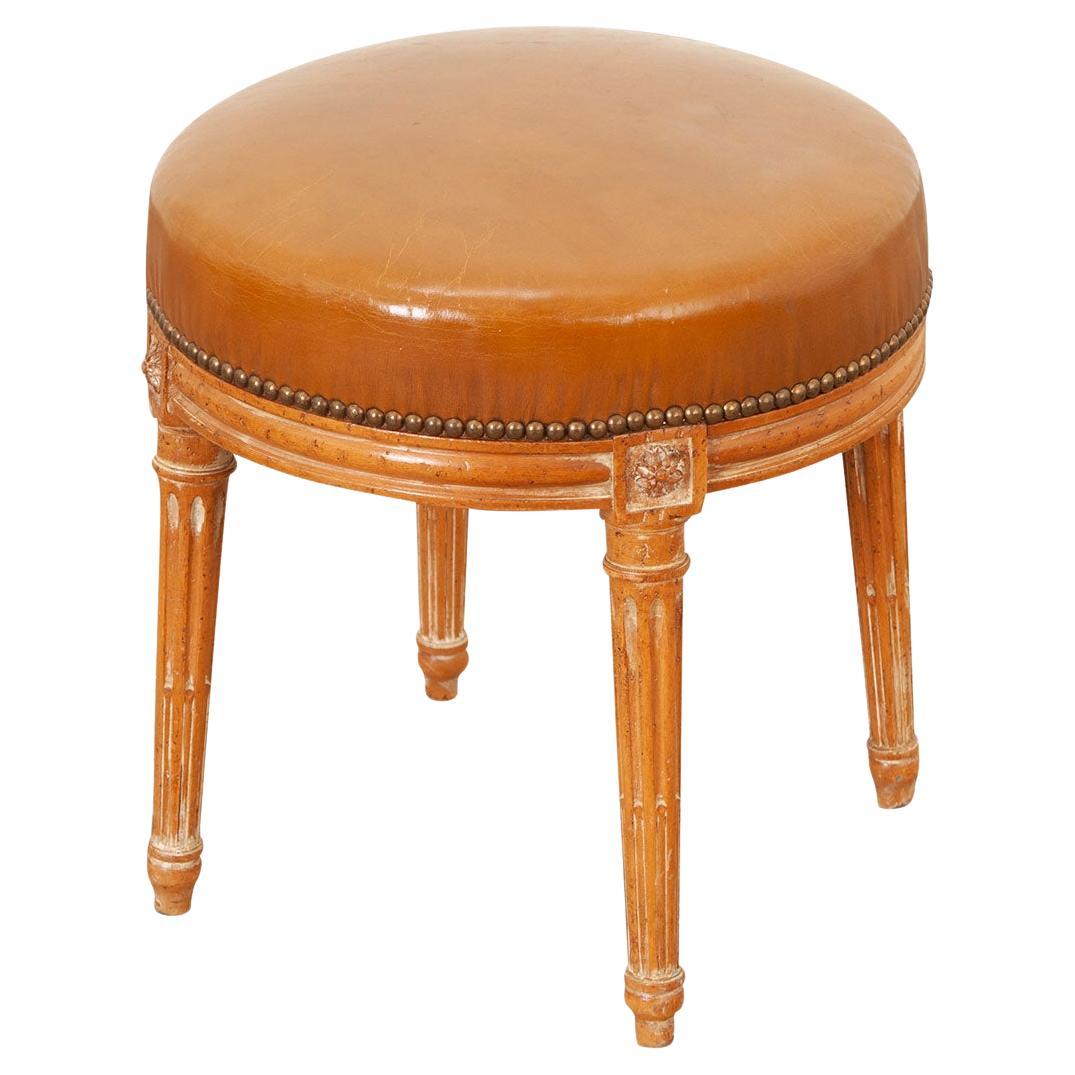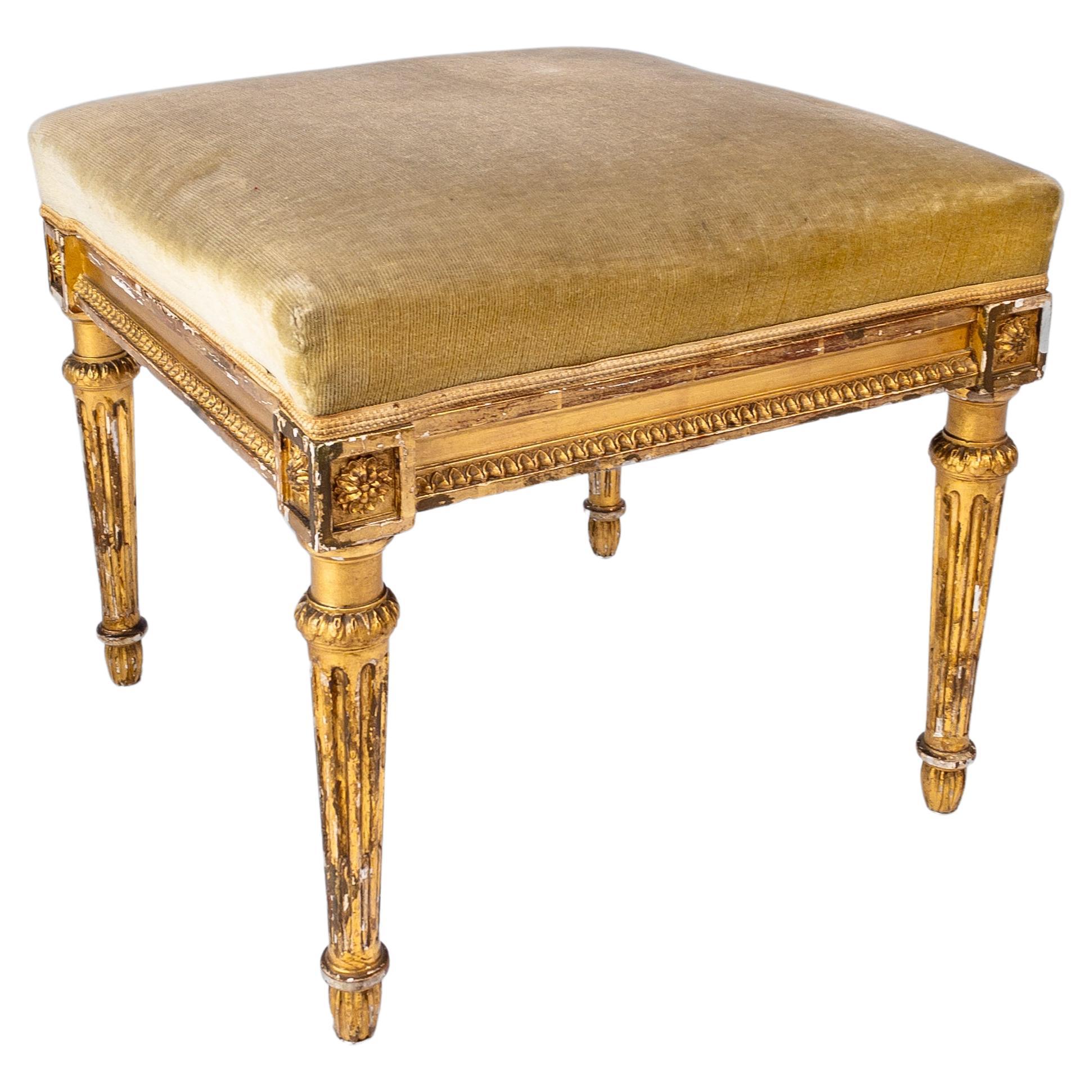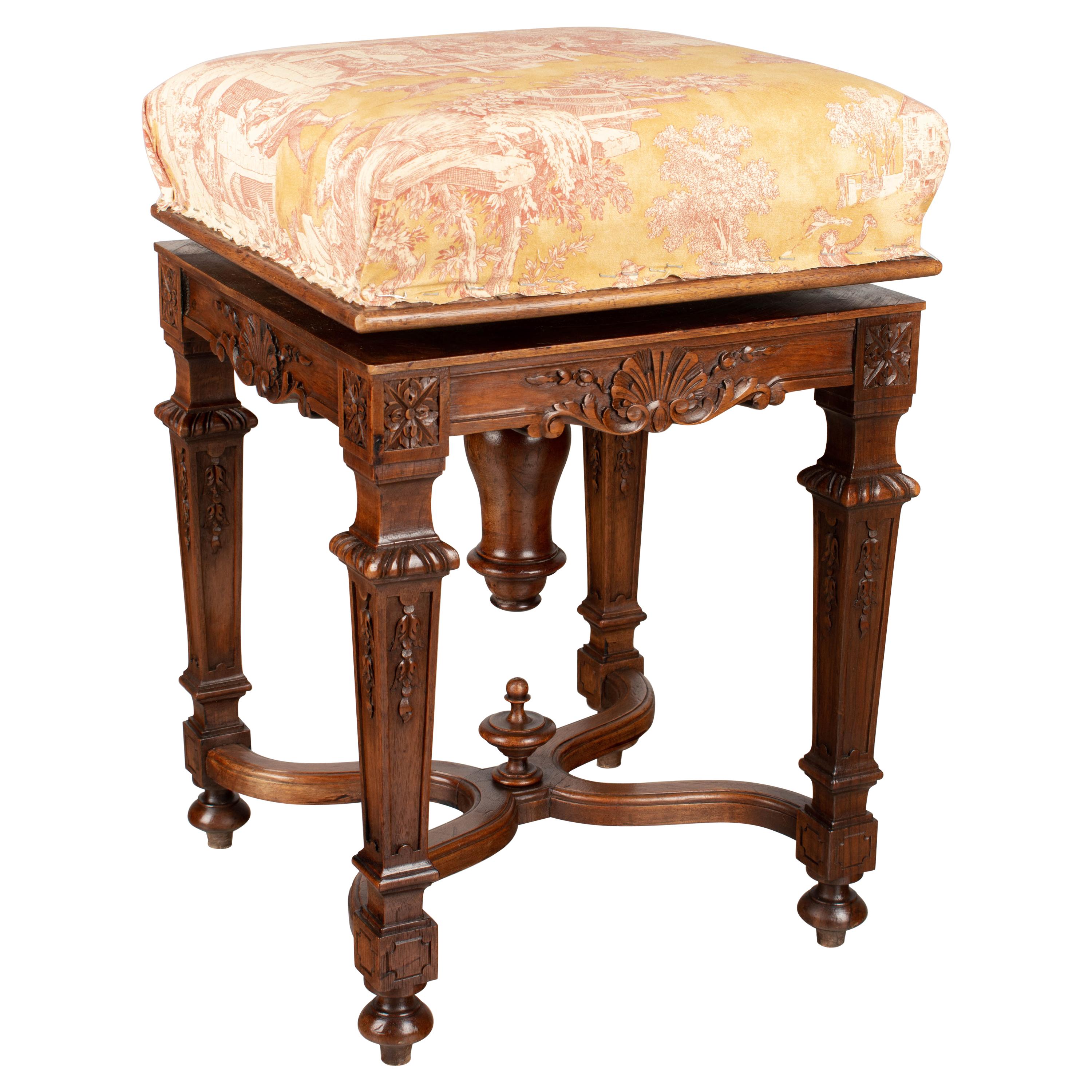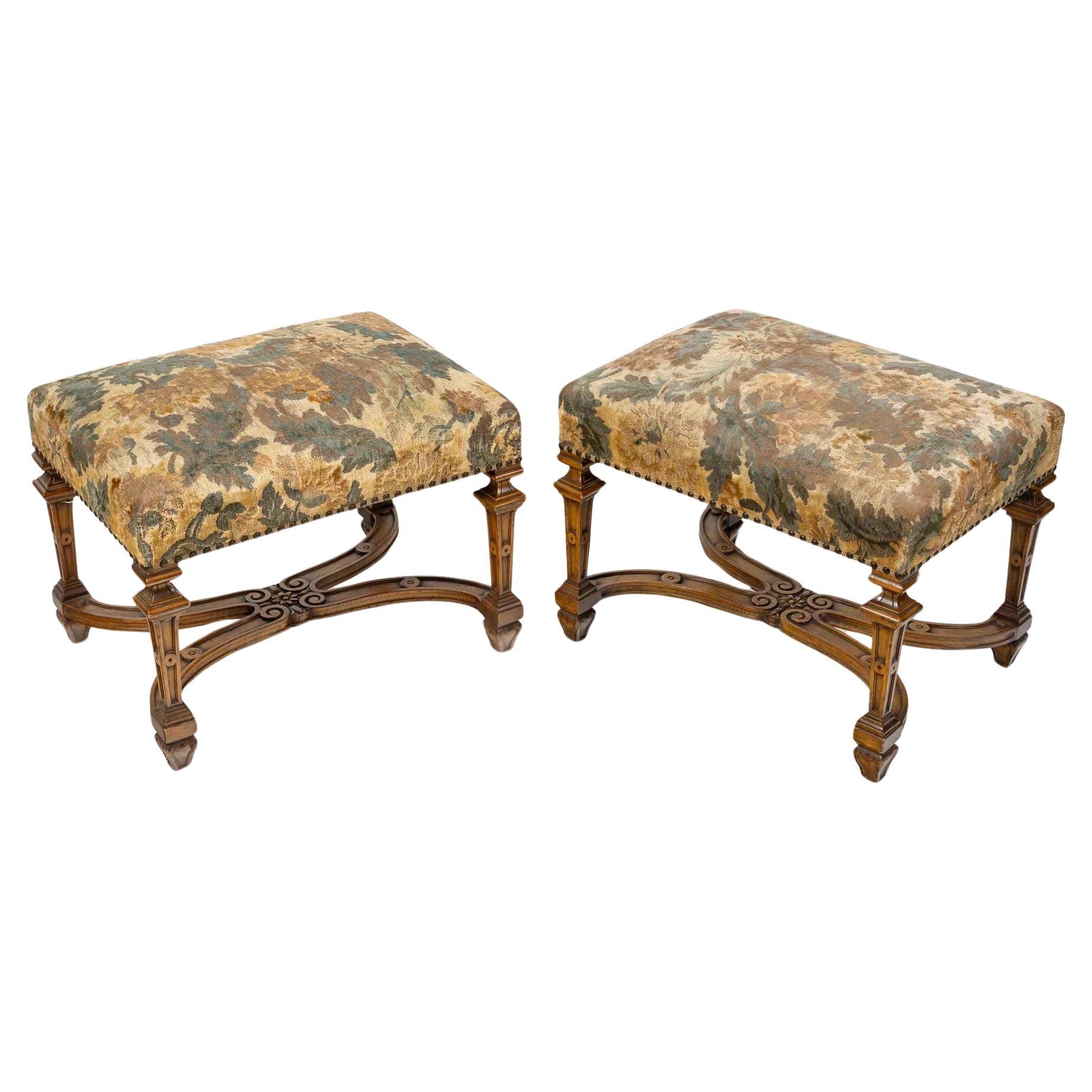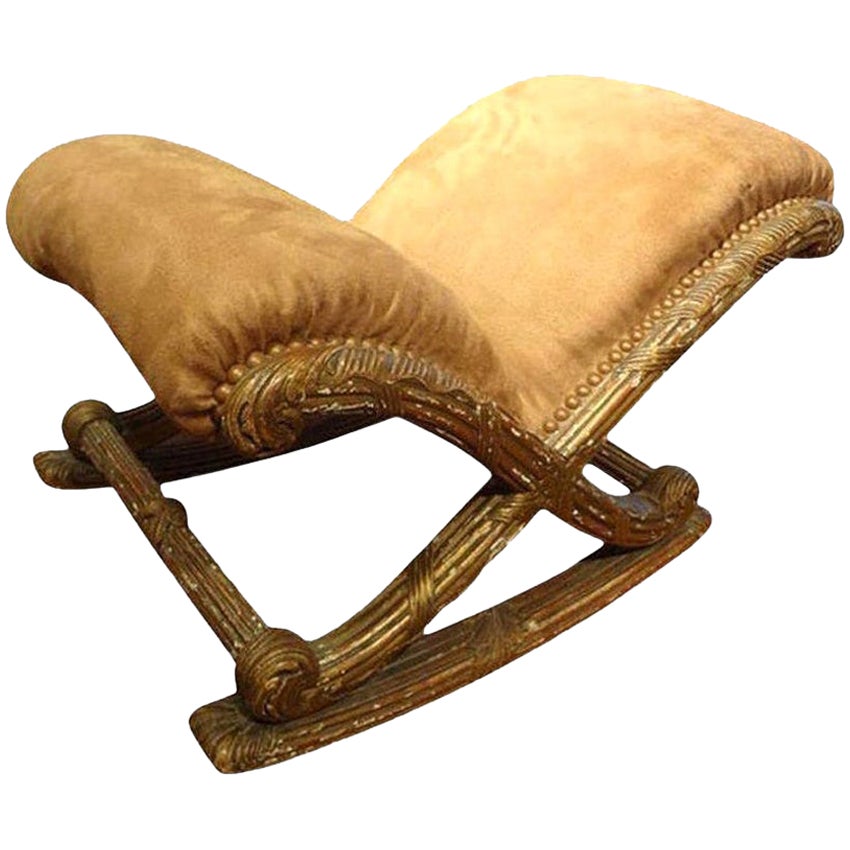Items Similar to A French 19th Century Pair of Louis XVI Style Large Curule Stools
Want more images or videos?
Request additional images or videos from the seller
1 of 8
A French 19th Century Pair of Louis XVI Style Large Curule Stools
About the Item
A French 19th Century Pair of Large Rectangular Curule Stools
Gilt and carved wood, decorated with interlace frieze, acanthus leaves and rosaces
The 4 feet linked by a gadrooned stretcher.
Louis XVI Style
Napoléon III Period
In the manner of Georges Jacob (1739-1814)
Attributed to Maison Jansen
Circa 1900
Used Petit Point Tapestry Upholstery
Maison Jansen, the French luxury:
Opulence, refinement, audacity of style marriages… so many words agree with Maison Jansen. Through this name, a whole era sounds like a reminder of a certain French chic…
Some names evoke immutable images, atmospheres... Like Jansen, for example. Let’s close our eyes… The 1960s and 1970s are at their peak. France is doing well. It is a country of full employment where everything seems possible. Within the international Jet Set, a carefree crowd of movie stars, public figures, literary idols and crowned heads, we love the Maison Jansen, its taste for styles struck with a good quality exuberance, and its brilliant side.
It all began in 1880, when the Dutchman Jean Henri Jansen founded the epon-ymous house in Paris. Jansen is part of the continuity of these world-famous furniture manufacturers and companies that operated under the Second Empire and at the time of the Universal Exhibitions, as the ‘Escalier de Cristal’ teaches. At that time, the Union Centrale des Beaux-Arts appliqués à l'Indus-trie and the Société du musée des Arts Décoratifs merged to form the Union Centrale des Arts Décoratifs.
Supported by both gallery owners, collectors and manufacturers, this organi-zation gives the «la» to the whole profession, and in the prevailing politico-ideological slump (France was defeated by Prussia in 1871 and Napoleon III is in exile), the ‘Union Centrale des Art Décoratifs’ focuses production on the celebration of past styles. While this nostalgia evokes memories of an era that we imagine more stable, an innovative exoticism will be all the rage: the reign of Turkish style and Japonisme.
The Jansen house masterfully rushed into the «exotic» trend, but quickly de-veloped a style derived from the ornamental splendor of the eighteenth, then a little later, so-called «imperial» styles mainly intended for royal families. Af-ter the First World War, J.H Jansen was joined by the cartoonist Albert Cazes, by Stéphane Boudin and by Pierre Delbée, who successively directed the house when it disappeared in 1929. At the end of the Kennedy era, Boudin complete-ly redecorated the White House, at the request of the First Lady, Jackie, who had fallen in love with his work after discovering it at Malmaison.
In 1971, Jansen joined forces with Leleu-Deshays and continued its quest for excellence. From 1969 to 1979, the dandy decorator Serge Robin took the reins of the house, granting it an eclectic and luxurious style: he revisited the great eras of French art, from the Renaissance to Louis XVI, by modernizing them with more contemporary pieces in Plexiglas or wrought iron. His recomposed and sophisticated style met with resounding success. When Jackie Kennedy, who became the wife of the great Greek shipowner Aristotle Onassis, moved to France, the young architect married Louis XVI-style furniture to modernist designs from the 1950s.
When the Shah of Iran decided to celebrate the 250th anniversary of the Per-sian Empire in 1971, Serge Robin and his teams turned to the grandiose and ephemeral setting of Persepolis. A hundred semi-trailers then left the work-shops on Rue Saint-Sabin to reach Tehran. At the same time, Princess Soraya of Iran commissioned her a sumptuous palace for Avenue Montaigne, the princes Faisal bin Fahd of Arabia and Mubarak Al-Sabah, and the Agnelli snatched it.
On the French side, he puts his talent at the service of Brigitte Bardot, for whom he completely revamped the Madrague and the Lannes boulevard.
Serge Robin embodies all the audacity of the name Jansen with the most im-probable weddings. With him, Plexiglas tables, Japanese chairs from the 50s, gold thread curtains, zebra sofas and leather Louis XVI style chests of drawers decorated the most fashionable apartments of the «seventies».
All the best stories have an end. At the dawn of the 1990s, weakened by the changes of a society plagued by concern, the disappearance or the remoteness of noble families, and the increasing scarcity of bourgeois residences, the Jan-sen house lost its aging clientele. The brand is missing the turn of modernity, and cannot adapt to changes in society, changing tastes, and the importance of design.
In 1989, it was closed. Jansen has not disappeared from the landscape: the house’s creations are still present on the market and in the French auction houses, but also in the United States, where they are very appreciated. Trans-parent Plexiglas tables, leather and metal armchairs, zebra sofas, exotic cabi-nets and chests of drawers in the Regency Style continue to find their place in some interiors, rekindling the flame of a time when we hoped for ever better tomorrow…
Georges Jacob is a French cabinet maker who produced an untold number of chairs from the reign of Louis XV to the Consulate. When he was an apprentice carpenter, he completed his journeyman internship with Louis Delanois, the supplier of the Comtesse du Barry. A fervent promoter of neoclassical sieges, Louis Delanois will exert an indisputable influence on Georges Jacob. Received master in 1765 he opened his workshop rue de Cléry then moved-in 1775 rue Meslée, thanks to a wealthy and royal clientele. In fact, requested from 1773 by the Garde-Meuble de la Couronne, he would not stop working for him until the Revolution. Georges Jacob is one of the official suppliers of Marie-Antoinette, but also of Monsieur, Count of Provence and brother of the King, future Louis XVIII, of the future Charles X, of the Prince of Condé, of the Duke of Penthièvre, as well as of the princes’ foreigners like the future Gustav III of Sweden and George IV of England.
An innovative cabinetmaker, he is often one step ahead of future trends and does not hesitate to imagine new decorations and new shapes of legs or seat arms such as connecting dice decorated with ro-settes, the finished console legs. at their top by a volute and the baluster-shaped armrest supports. The carved ornamentation of his furniture is abundant with recurring themes such as natural motifs of flowers and foliage, and friezes of foliage, piastres, ribbons, pearls, and interlacing. He was one of the promoters of English seats, with openwork backs inspired by Chippendale and Adam, as well as the initiator, from the Louis XVI period of the characteristic shapes of what we call today the Directoire style, inspired among other things by “Etruscan” furniture. While his friendship with the painter Jacques-Louis David enabled him to navigate the Revolution without a hitch, he quickly encountered other problems. In fact, in 1796 he sold his business to these two sons who thus founded “Jacob Frères” but unfortunately the eldest, Georges II, died in 1803. Georges Jacob father would then reconstitute with his second son François-Honoré-Georges a business, Georges Jacob senior died in his home rue Meslée in 1814.
- Attributed to:Maison Jansen (Cabinetmaker)
- Similar to:Georges Jacob (Cabinetmaker)
- Dimensions:Height: 17.72 in (45 cm)Width: 31.5 in (80 cm)Depth: 19.69 in (50 cm)Seat Height: 19.69 in (50 cm)
- Sold As:Set of 2
- Style:Louis XVI (In the Style Of)
- Materials and Techniques:
- Place of Origin:
- Period:
- Date of Manufacture:circa 1900
- Condition:Wear consistent with age and use.
- Seller Location:Saint-Ouen, FR
- Reference Number:1stDibs: LU2612338446502
About the Seller
4.9
Vetted Seller
These experienced sellers undergo a comprehensive evaluation by our team of in-house experts.
1stDibs seller since 2017
57 sales on 1stDibs
Typical response time: 1 hour
- ShippingRetrieving quote...Ships From: Saint-Ouen, France
- Return PolicyA return for this item may be initiated within 2 days of delivery.
More From This SellerView All
- A French 19th Century Pair of Louis XIV Style StoolsLocated in Saint-Ouen, FRA French 19th Century Pair of Large Rectangular Stools natural and carved wood. The 4 sheaths feet carved and linked by a stretcher. Louis XIV Style Napoléon III Period Circa 1880 Used Petit Point Tapestry Upholstery If the stool played a great role at the court of Louis XIV, it was also the pretext of a war... that of the stools precisely, recounted by Saint-Simon. The Duchesses fought and the Duchesse became a seat with very curious forms. There were benches and chairs, then armchairs, not to mention stools. A seat dear to the duchesses. Some fought for one, to sit in the presence of the queen. Standing, while others, sometimes cousins, were seated, was intolerable. The Duke of Saint-Simon was pleased to recount the «war of stools». This one was provoked by Mme de Chevreuse who sat, without any way, before Queen Anne of Austria...Category
Antique 1880s French Louis XIV Stools
MaterialsBeech
- Pair of French Napoléon III Curule ArmchairsLocated in Saint-Ouen, FRPair of French Napoléon III Curule Armchairs Moulded, carved, blackened wood, enhanced with gold. Open-banded back decorated with interlacing, X-bas...Category
Antique 1890s French Napoleon III Armchairs
MaterialsWood, Trimming
- A French 19th Century Louis XVI Style Side Table, circa 1880Located in Saint-Ouen, FRA very good quality 19th century French charming two-tier side table with a single frieze drawer parquetry inlaid, designed with Allegories of Geography and Astronomy, with pierced three-quarter gallery surround, above a foliate and loop frieze, the front with a drawer, ormolu mounts and raised on delicate cabriole legs. The Louis XVI furnishings and decorative style started in 1774, at the begin-ning of Louis XVI reign up until 1790. The Directoire style will succeed. It followed a European movement return to classicism in the second half of the eighteenth century. Louis XVI, grand-son of Louis XV, became king in 1774 at the age of 20. Queen Marie Antoinette also very much appreciated the decorative arts. The middle of the eighteenth century and the Louis XVI style furnishing has been heavily influenced by the discovery of the remains of Herculaneum (1738) and Pompeii in 1748. Thus, was born the neo...Category
Antique 1880s French Louis XVI Side Tables
MaterialsOrmolu
- A Very Fine Quality 19th Century French Pair of CandlesticksLocated in Saint-Ouen, FRVery Fine French 19th Century Pair of Candlesticks In ormolu, very finely chiseled and decorated with knotted garlands, branches of leafy flowers, spokes of hearts, leaves of water...Category
Antique 1870s French Louis XVI Candlesticks
MaterialsOrmolu
- French 19th Century Pair of Porcelain Cache-PotsLocated in Saint-Ouen, FRPair of polychromed hand painted porcelain with Japonisme floral decoration Ormolu-mounted with open-worked base and rim Louis XVI Style circa 1880.Category
Antique 1870s French Chinoiserie Planters, Cachepots and Jardinières
MaterialsOrmolu
- 19th Century French Lacquered Wood ChandelierLocated in Saint-Ouen, FRA 19th century French polychromed lacquered wood eight-light chandelier Lacquered gloss cream wood with green, red and brown highlights Contained vase ending in foliated seed welcoming eight arms forming semicircles. The top has a frieze of red flowers in green interlacing and is topped with leaves and a painted egg cream...Category
Antique 1890s French Louis XVI Chandeliers and Pendants
MaterialsWood
You May Also Like
- French 19th Century Louis XVI-Style StoolLocated in Baton Rouge, LAA charming, antique European stool. The cut velvet upholstery cushion has nailhead trim and sits atop a carved apron with floret dies at the four corners. The whole is raised on flut...Category
Antique 19th Century French Louis XVI Stools
MaterialsUpholstery
- French 19th Century Louis XVI Style StoolLocated in Baton Rouge, LAA beautiful vintage stool perfect for any space. Made in France, this 19th century stool has a brightly colored leather upholstered seat, atop four elegantly fluted and tapered legs ...Category
Antique 19th Century French Louis XVI Stools
MaterialsLeather, Wood
- 19th Century French Louis XVI Style Gilt StoolLocated in Houston, TXExquisite and refined, this 19th-century French Louis XVI Style Gilt Stool epitomizes the elegance and sophistication of its era. Crafted with meticulous attention to detail, the sto...Category
Antique 19th Century French Louis XVI Stools
MaterialsFabric, Upholstery, Wood, Giltwood
- 19th Century Louis XVI French Adjustable StoolLocated in Winter Park, FLA 19th century French Louis XVI style adjustable swivel stool made of solid hand carved walnut with x-stretcher and wood finials. The seat of this small stool may be easily adjusted ...Category
Early 20th Century French Louis XVI Swivel Chairs
MaterialsWalnut
- 19th Century French Louis XVI Style Giltwood FootstoolLocated in Houston, TX19th century French Louis XVI style giltwood footstool. Unusual antique French Napoleon III gilt wood footstool, stool or tabouret with beautiful patina. This great French Louis XVI...Category
Antique 19th Century French Louis XVI Footstools
MaterialsGiltwood
- Late 19th Century Carved Oak Louis XVI StoolLocated in Hudson, NYThis stool is done in oak with great color and deep rich hand carving. Created in the last decade of the 19th century, the stool's apron is carved in a twisted ribbon that centers on...Category
Antique 1890s French Louis XVI Stools
MaterialsOak
Recently Viewed
View AllMore Ways To Browse
Plexiglass And Leather Sofa
4 Empire Side Chairs
Plexi Stool
French Modernist Rush Chairs
Wood Barstool With Back
Studio Qasabian
Stools Modern
Very Large Stools
Pair Of Tall Stools
Vintage Mid Century Counter Stools
Sheep Fur Stool
Mid Century Counter Stools With Backs
Chic Wrought Iron Counter Stool
Cloud Garden Stool
Cojo Bar Stool
Cojo Stool
Counter Stools A Rudin
Design For Leisure On Sale
